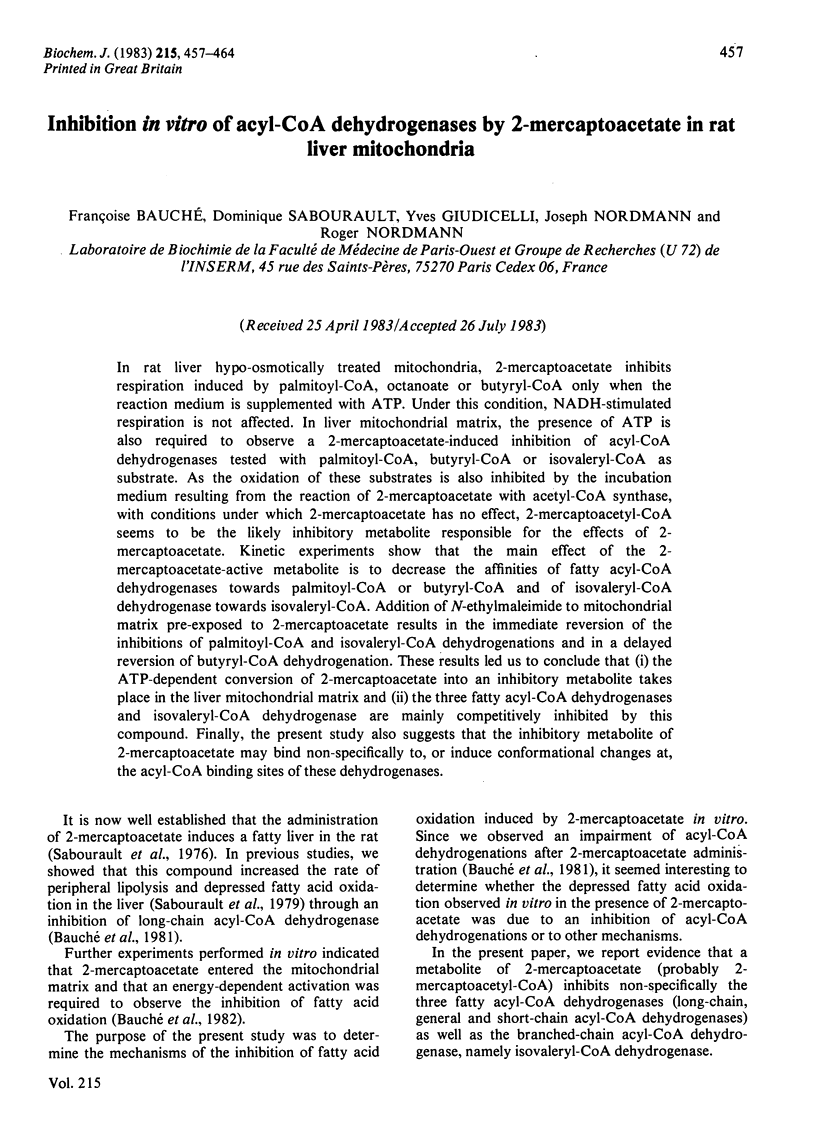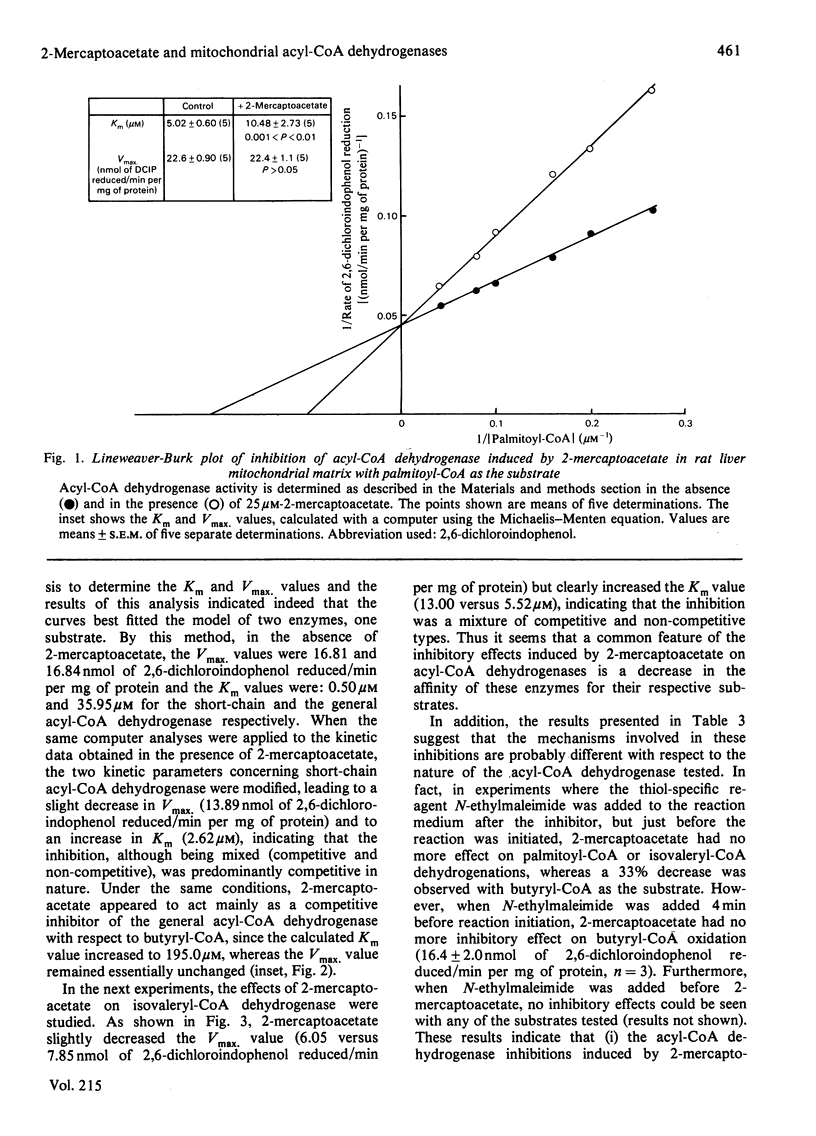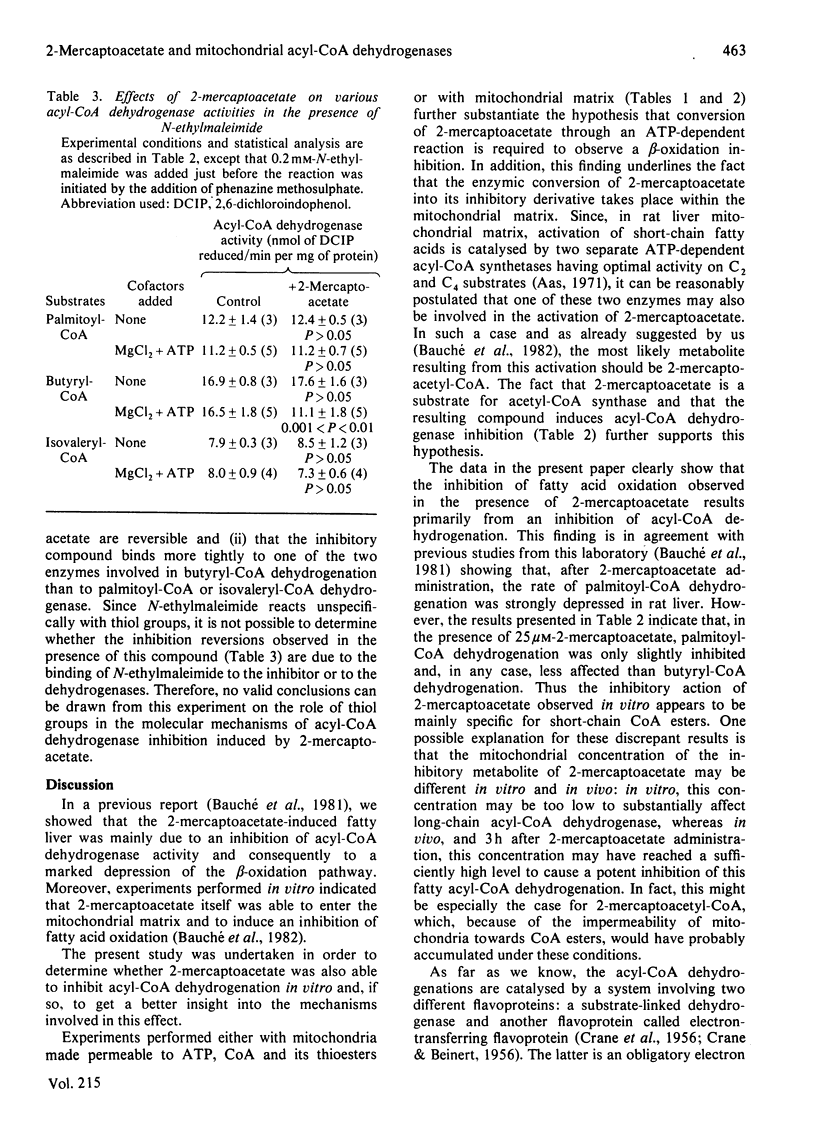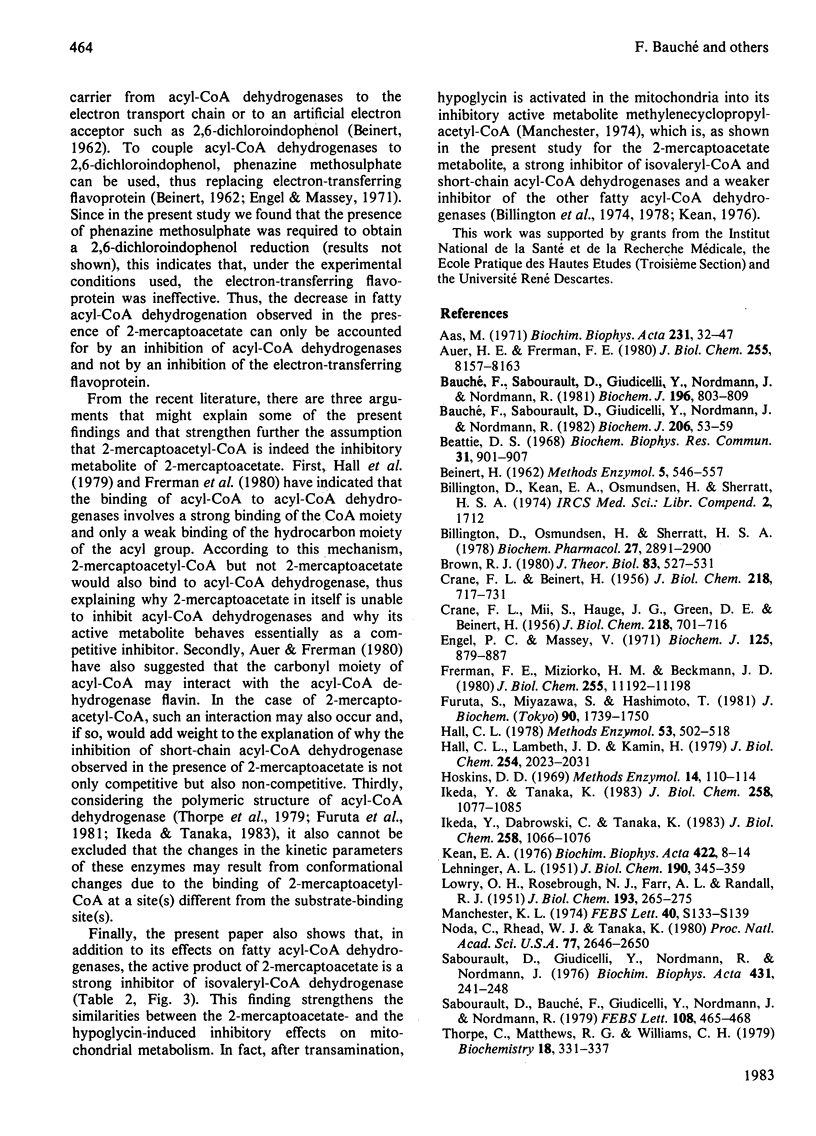Abstract
In rat liver hypo-osmotically treated mitochondria, 2-mercaptoacetate inhibits respiration induced by palmitoyl-CoA, octanoate or butyryl-CoA only when the reaction medium is supplemented with ATP. Under this condition, NADH-stimulated respiration is not affected. In liver mitochondrial matrix, the presence of ATP is also required to observe a 2-mercaptoacetate-induced inhibition of acyl-CoA dehydrogenases tested with palmitoyl-CoA, butyryl-CoA or isovaleryl-CoA as substrate. As the oxidation of these substrates is also inhibited by the incubation medium resulting from the reaction of 2-mercaptoacetate with acetyl-CoA synthase, with conditions under which 2-mercaptoacetate has no effect, 2-mercaptoacetyl-CoA seems to be the likely inhibitory metabolite responsible for the effects of 2-mercaptoacetate. Kinetic experiments show that the main effect of the 2-mercaptoacetate-active metabolite is to decrease the affinities of fatty acyl-CoA dehydrogenases towards palmitoyl-CoA or butyryl-CoA and of isovaleryl-CoA dehydrogenase towards isovaleryl-CoA. Addition of N-ethylmaleimide to mitochondrial matrix pre-exposed to 2-mercaptoacetate results in the immediate reversion of the inhibitions of palmitoyl-CoA and isovaleryl-CoA dehydrogenations and in a delayed reversion of butyryl-CoA dehydrogenation. These results led us to conclude that (i) the ATP-dependent conversion of 2-mercaptoacetate into an inhibitory metabolite takes place in the liver mitochondrial matrix and (ii) the three fatty acyl-CoA dehydrogenases and isovaleryl-CoA dehydrogenase are mainly competitively inhibited by this compound. Finally, the present study also suggests that the inhibitory metabolite of 2-mercaptoacetate may bind non-specifically to, or induce conformational changes at, the acyl-CoA binding sites of these dehydrogenases.
Full text
PDF







Selected References
These references are in PubMed. This may not be the complete list of references from this article.
- Aas M. Organ and subcellular distribution of fatty acid activating enzymes in the rat. Biochim Biophys Acta. 1971 Feb 2;231(1):32–47. doi: 10.1016/0005-2760(71)90253-0. [DOI] [PubMed] [Google Scholar]
- Auer H. E., Frerman F. E. Circular dichroism studies of acyl-CoA dehydrogenase and electron transfer flavoprotein. J Biol Chem. 1980 Sep 10;255(17):8157–8163. [PubMed] [Google Scholar]
- Bauché F., Sabourault D., Giudicelli Y., Nordmann J., Nordmann R. 2-Mercaptoacetate administration depresses the beta-oxidation pathway through an inhibition of long-chain acyl-CoA dehydrogenase activity. Biochem J. 1981 Jun 15;196(3):803–809. doi: 10.1042/bj1960803. [DOI] [PMC free article] [PubMed] [Google Scholar]
- Bauché F., Sabourault D., Giudicelli Y., Nordmann J., Nordmann R. Effects of 2-mercaptoacetate in isolated liver mitochondria in vitro. Competitive inhibition of 3-hydroxybutyrate dehydrogenase and depression of the beta-oxidation pathway. Biochem J. 1982 Jul 15;206(1):53–59. doi: 10.1042/bj2060053. [DOI] [PMC free article] [PubMed] [Google Scholar]
- Beattie D. S. Enzyme localization in the inner and outer membranes of rat liver mitochondria. Biochem Biophys Res Commun. 1968 Jun 28;31(6):901–907. doi: 10.1016/0006-291x(68)90537-8. [DOI] [PubMed] [Google Scholar]
- Billington D., Osmundsen H., Sherratt H. S. Mechanisms of the metabolic disturbances caused by hypoglycin and by pent-4-enoic acid. In vivo studies. Biochem Pharmacol. 1978;27(24):2891–2900. doi: 10.1016/0006-2952(78)90205-8. [DOI] [PubMed] [Google Scholar]
- Brown R. J. Application of non-linear least squares fitting to analysis of inhibition in biphasic kinetic systems. J Theor Biol. 1980 Apr 7;83(3):527–531. doi: 10.1016/0022-5193(80)90060-0. [DOI] [PubMed] [Google Scholar]
- CRANE F. L., BEINERT H. On the mechanism of dehydrogenation of fatty acyl derivatives of coenzyme A. II. The electron-transferring flavoprotein. J Biol Chem. 1956 Feb;218(2):717–731. [PubMed] [Google Scholar]
- CRANE F. L., MII S., HAUGE J. G., GREEN D. E., BEINERT H. On the mechanism of dehydrogenation of fatty acyl derivatives of coenzyme A. I. The general fatty acyl coenzyme A dehydrogenase. J Biol Chem. 1956 Feb;218(2):701–706. [PubMed] [Google Scholar]
- Engel P. C., Massey V. The purification and properties of butyryl-coenzyme A dehydrogenase from Peptostreptococcus elsdenii. Biochem J. 1971 Dec;125(3):879–887. doi: 10.1042/bj1250879. [DOI] [PMC free article] [PubMed] [Google Scholar]
- Frerman F. E., Miziorko H. M., Beckmann J. D. Enzyme-activated inhibitors, alternate substrates, and a dead end inhibitor of the general acyl-CoA dehydrogenase. J Biol Chem. 1980 Dec 10;255(23):11192–11198. [PubMed] [Google Scholar]
- Furuta S., Miyazawa S., Hashimoto T. Purification and properties of rat liver acyl-CoA dehydrogenases and electron transfer flavoprotein. J Biochem. 1981 Dec;90(6):1739–1750. doi: 10.1093/oxfordjournals.jbchem.a133651. [DOI] [PubMed] [Google Scholar]
- Hall C. L. Acyl-CoA dehydrogenases and electron-transferring flavoprotein. Methods Enzymol. 1978;53:502–518. doi: 10.1016/s0076-6879(78)53053-x. [DOI] [PubMed] [Google Scholar]
- Hall C. L., Lambeth J. D., Kamin H. Acyl-CoA complexes of general acyl-CoA dehydrogenase and electron transfer flavoprotein. J Biol Chem. 1979 Mar 25;254(6):2023–2031. [PubMed] [Google Scholar]
- Ikeda Y., Dabrowski C., Tanaka K. Separation and properties of five distinct acyl-CoA dehydrogenases from rat liver mitochondria. Identification of a new 2-methyl branched chain acyl-CoA dehydrogenase. J Biol Chem. 1983 Jan 25;258(2):1066–1076. [PubMed] [Google Scholar]
- Ikeda Y., Tanaka K. Purification and characterization of isovaleryl coenzyme A dehydrogenase from rat liver mitochondria. J Biol Chem. 1983 Jan 25;258(2):1077–1085. [PubMed] [Google Scholar]
- Jolchine G., Reiss-Husson F. Comparative studies on two reaction center preparations from Rhodopseudomonas speheroides Y. FEBS Lett. 1974 Mar 15;40(1):5–8. doi: 10.1016/0014-5793(74)80881-1. [DOI] [PubMed] [Google Scholar]
- Kean E. A. Selective inhibition of acyl-CoA dehydrogenases by a metabolite of hypoglycin. Biochim Biophys Acta. 1976 Jan 23;422(1):8–14. doi: 10.1016/0005-2744(76)90003-6. [DOI] [PubMed] [Google Scholar]
- LOWRY O. H., ROSEBROUGH N. J., FARR A. L., RANDALL R. J. Protein measurement with the Folin phenol reagent. J Biol Chem. 1951 Nov;193(1):265–275. [PubMed] [Google Scholar]
- Noda C., Rhead W. J., Tanaka K. Isovaleryl-CoA dehydrogenase: demonstration in rat liver mitochondria by ion exchange chromatography and isoelectric focusing. Proc Natl Acad Sci U S A. 1980 May;77(5):2646–2650. doi: 10.1073/pnas.77.5.2646. [DOI] [PMC free article] [PubMed] [Google Scholar]
- Sabourault D., Bauché F., Giudicelli Y., Nordmann J., Nordmann R. Inhibitory effect of 2-mercaptoacetate on fatty acid oxidation in the liver. FEBS Lett. 1979 Dec 15;108(2):465–468. doi: 10.1016/0014-5793(79)80589-x. [DOI] [PubMed] [Google Scholar]
- Sabourault D., Giudicelli Y., Nordmann R., Nordmann J. Is fatty liver induction a general feature of the administration of foreign sulfhydryl compounds? Biochim Biophys Acta. 1976 May 27;431(2):241–248. doi: 10.1016/0005-2760(76)90144-2. [DOI] [PubMed] [Google Scholar]


